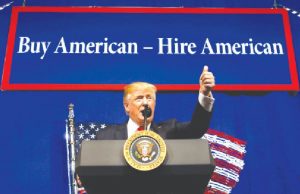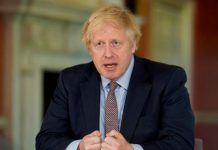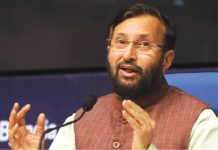 Before the outbreak of pandemic, there were signs of recession in the United States. Starting in March 2020, job loss was rapid. About 16 million jobs were lost in the United States in three weeks ending on April 4, 2020. Unemployment claims reached a record high. On 8th May, the Bureau of Labour Statistics reported a U-3 unemployment figure of 14.7 per cent, the highest level recorded since 1941, with U-6 unemployment (total unemployed and part time underemployed workers) reaching 22.8 per cent. Approximately 5.4 million Americans lost their health insurance from February to May 2020 after losing their jobs.
Before the outbreak of pandemic, there were signs of recession in the United States. Starting in March 2020, job loss was rapid. About 16 million jobs were lost in the United States in three weeks ending on April 4, 2020. Unemployment claims reached a record high. On 8th May, the Bureau of Labour Statistics reported a U-3 unemployment figure of 14.7 per cent, the highest level recorded since 1941, with U-6 unemployment (total unemployed and part time underemployed workers) reaching 22.8 per cent. Approximately 5.4 million Americans lost their health insurance from February to May 2020 after losing their jobs.
The largest economic stimulus legislation in American history, a $2 trillion package called the Corona virus Aid, Relief, and Economic Security Act (CARES Act) was signed into law on March 27, 2020.
Immigration policy
In January 2017, after taking over as the President of the United States, Donald Trump had hinted that the low-cost workers hampered the progress in the economy and undercutting jobs of citizens. The President hinted at reforming the “broken” H-1B visa system. Trump administration seized the opportunity provided by the economic contraction due to Covid-19 outbreak by first banning the entry of non-immigrant workers till June 23, and then extending it till December 31, 2020.
On April 22, 2020, a proclamation was signed to discontinue the entry into the United States of certain immigrants who presented risk to the U.S. labour market during the economic recovery following the COVID-19 outbreak. The proclamation became effective on April 23, 2020. On June 22, 2020, the President signed Presidential Proclamation (P.P.) 10052 that extended P.P. 10014, discontinuing the entry to the United States of certain immigrant visa applicants and also the entry to the United States of certain additional foreign nationals. The suspension, specifically, applies to applicants for H-1B, H-2B, L-1 visas and J-1 applicants. His argument was that the devastating economic impact of the corona virus pandemic has forced officials to do more to protect American jobs. The Trump administration had said that this move could free up a total of 5, 25,000 jobs to be filled by American nationals.
On August 3, 2020, the President further signed an executive order to restrict H1B Visa use. The executive order is to ensure that the federal government lives by a very simple rule. ‘Hire American’. The step was for protecting the American workforce.
Trump added that H1B regulation is finalised so that no American worker is replaced ever again. H1B visa must be used for top highly paid talent to create American jobs, not as expensive labour programmes and destroy American jobs. The order also restricts the ability of American companies with global operations and international companies with U.S. branches to transfer foreign executives and other employees to the United States for months or years long stints. And, it blocks the spouses of foreigners who are employed at companies in the United States.
The executive order requires all federal agencies to complete an internal audit within 120 days and assess whether they are in compliance with the requirement that only US citizens and nationals are appointed to the competitive service. Officials of White house added that the ban on worker visas, combined with extending restrictions on the issuance of new green cards, would keep as many as 525,000 foreign workers out of the country for the rest of the year.
Stephen Miller, the White House aide and the architect of Trump’s immigration policy, has pushed for years to limit or eliminate the worker visas, arguing that they harm employment prospects for Americans. In recent months, he has argued that the economic distress caused by the virus has made it even more important to turn off the spigot. But this move has been fiercely opposed by business leaders, who say it will block their ability to recruit critically needed workers from countries overseas.
The signing of H1B Visa
As a result of the executive order, the Labour Department of United States of America will also finalise guidelines to prevent H1B employers from moving H1B workers to other employer’s job sites in order to displace American workers.
What pushed the US govt. to suspend non-immigrant worker visas? The US government’s order had followed just after the announcement made by the federally owned Tennessee Valley Authority’s (TVA) that it will outsource 20 per cent of its technology jobs to the companies based in the foreign countries. As per the President, Tennessee Valley Authority’s step will cause more than 200 highly skilled American tech workers in losing their jobs to low-wage, as foreign workers will be hired on temporary work visas. He added that outsourcing hundreds of workers is especially problematic amid the pandemic which has already cost millions of American citizens their jobs. Additionally, given the current climate of intellectual property theft, outsourcing IT jobs involves sensitive information that will also pose a National security risk.
The H-1B is a visa in the United States under the Immigration and Nationality Act, section 101(a)(15)(H) that allows U.S. employers to temporarily employ foreign workers in specialty occupations. A specialty occupation requires the application of specialized knowledge and a bachelor’s degree or the equivalent of work experience. Through the H-1B visa, US companies are eligible to employ international workers in speciality occupations where a graduate university is required. The so-called ‘Person in Specialty Occupation’ visa allows companies to hire tens of thousands of employees each year from different countries. According to MPI’s estimates, some 19,000 dependents on H-4 visas could be affected.
H-2B visa
The H-2B program allows US employers or agents to bring foreign nationals to the United States to fill temporary non-agricultural jobs. They generally apply to seasonal workers in a wide variety of industries, according to the National Immigration Forum, including landscaping, forestry, hospitality and construction. Some 23,000 people, according to MPI estimate could be affected
J-1 visa
The J-1 visa is an exchange visitor visa for individuals approved to participate in work- and study-based exchange visitor programs. Trump’s proclamation lists a number of impacted workers, including interns, trainees, teachers, camp counsellors, au pairs and participants in summer work travel programs. As per MPI estimate, 72,000 can be affected (plus some 11,000 dependents on J-2 visas).
L-1 visa:
The L-1 visa category covers temporary intra company transferees who work in managerial positions or have specialized knowledge. This category covers Managers, executives and employees with specialized knowledge. Quite likely, some 6,000 (plus some 7,000 dependents on L-2 visas) can be affected.
Reactions
According to Todd Schulte, the President of FWD, “This is a full-frontal attack on American innovation and our nation’s ability to benefit from attracting talent from around the world.”
Thomas J. Donohue, the chief executive of the U.S. Chamber of Commerce observed, “Restrictive changes to our nation’s immigration system will push investment and economic activity abroad, slow growth and reduce job creation.”
Visa woes:
The H-1B work visa program has become the target of US lawmakers in this situation. This visa program is the most coveted foreign work visas for technology professionals. Indian techies are the largest beneficiaries of the visa program. The suspension order for H-1B will have an adverse impact on thousands of Indian IT professionals. A large number of Indians on the H-1B visa have already lost their job and headed back home during the pandemic.
As reported on August 6, 2020, the US government has said that nearly 1.2 million workers have applied for new claims for state unemployment benefits. An additional 6,50,000 claims were filed by free lancers, part-time workers and others who do not qualify for regular jobless aid but are eligible for benefits under a separate unemployment insurance programme. With the dramatic rise in unemployment levels, the US government wants to ensure every possible step to provide employment for the local Americans. Does Trump wants to justify his move or is it to woo the Americans as the presidential election is on the card and is likely on its way. Future can only say.
The author is an Associate Professor & Dean of National University of Study & Research in Law. Views are her own
letters@tehelka.com












